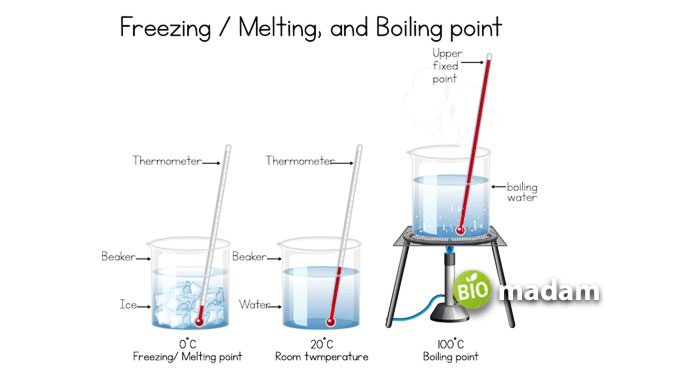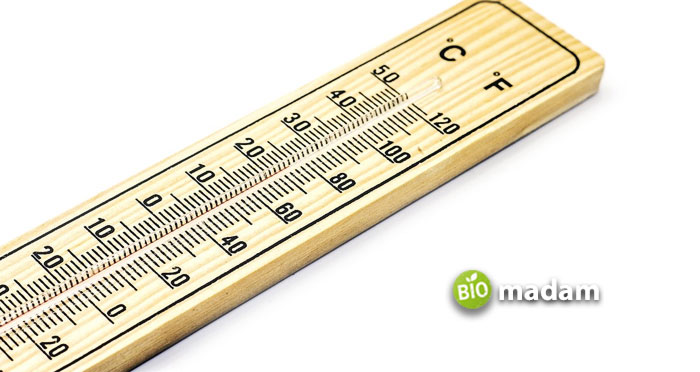Temperature is an important element for understanding weather and climate in different regions of the world. In old times, scientists had unique tools and goals, giving birth to various temperature-recording systems. Thus, different parameters help measure the temperature in varying ecosystems and biomes. Fahrenheit and Celsius are two of the three scales for measuring temperature. The temperature of one object will be different in both systems depending on the measurement introduced by the scientists.
Keep reading to learn all the differences between Celsius and Fahrenheit.
Comparison Table
| Characteristic | Celsius | Fahrenheit |
| Denoted By | °C | °F |
| Introduction | 1842 A.D. | 1720 A.D. |
| Named After | Andres Celsius | D. Gabriel Fahrenheit |
| Freezing Point | 0°C | 32°F |
| Boiling Point | 100°C | 212°C |
| Absolute Zero | -273.15°C | -459.67°F |
| Divisions | 100 | 180 |
| Human Body Temperature | 37°C | 98.6°F |
| Formula of Conversion | °C = (°F – 32) × 5/9 | °F = (9/5 × °C) + 32 |
| Application | Metric System and most countries | U.S. of America |
What is Celsius?
Celsius is a scale of temperature measurement used widely in numerous countries globally to record the temperature of objects and their surroundings. It is identified as the scale which gives the freezing point of pure water at sea level without additional pressure, at 0 degrees Celsius. Similarly, the boiling point of water lies at 100 degrees Celsius. Celsius is also known as Centigrade because of the difference of 100 units between the melting and boiling point.

History of Celsius
A Swedish astronomer named Anders Celsius introduced the Celsius system in 1842 A.D. The initial numbers proposed by Anders Celsius worked opposite to the scale we use today. Initially, he used 0°C for the boiling point of water and 100°C for the melting point of ice.
However, the Celsius scale was further modified on the basis of the triple point of Vienna Standard Mean ocean water. It has helped improve the concept of absolute zero by omitting freezing or boiling points as the base of the temperature measurement system.
Thus, the absolute zero, or the lowest possible temperature, is now defined at -273.15°C or 0K. Previously, the triple point of water was denoted at 273.16 K or 0.01 °C.
Fahrenheit or Kelvin to Celsius Conversion
The formula scientists and students use to convert the temperature of different types of ecosystems or objects recorded in Fahrenheit is:
°C = (°F – 32) × 5/9
The formula can be explained as follows:
Subtract 32, multiply by 5, and divide by 9.
To convert Kelvin into Celsius, use the following equation:
C = K – 273.15
What is Fahrenheit?
Fahrenheit is another scale to observe the physical changes in an object in the form of temperature measurement. It is also used to indicate the weather in different communities and ecosystems, just like Celsius. The relative values of freezing and boiling point result in the difference between Celsius and Fahrenheit. The boiling point of water in Fahrenheit is 212°F, while the freezing point is 32°F. Contrary to Celsius, Fahrenheit endpoints have a difference of 180 degrees. This type of temperature measurement system is used in the U.S. primarily.

History of Fahrenheit
Daniel Gabriel Fahrenheit introduced the Fahrenheit scale in 1720 A.D. Daniel initially opted for 30° as the freezing point of water. However, it was revised later. The lowest defining point (32°F) refers to the freezing point of brine, including an equal amount of water, ammonium chloride, and ice.
Celsius or Kelvin to Fahrenheit Conversion
As all temperature scales are interconvertible, you can use this formula to convert Celsius temperature to Fahrenheit:
°F = (9/5 × °C) + 32
It can be explained as:
Multiply by 9, divide by 5, and add 32.
Moreover, the conversion from Kelvin into Fahrenheit can be obtained by:
F = 1.8 × (K-273) + 32
Difference Between Celsius and Fahrenheit
Definition
Celsius
Celsius is a temperature measuring system based on the triple point of water.
Fahrenheit
Fahrenheit is a temperature scale that uses the freezing and boiling point of brine as basic parameters.
Symbol
Celsius
Celsius is denoted by °C (degrees Celsius/degree Centigrade).
Fahrenheit
On the other hand, the unit for Fahrenheit is the degree Fahrenheit indicated by °F.
History
Celsius
Swedish astronomer Andres Celsius introduced the Celsius system in 1842 A.D.
Fahrenheit
Whereas, Daniel Gabriel Fahrenheit introduced the Fahrenheit scale in 1720 A.D.
Freezing Point
Celsius
The freezing point of water on the Celsius scale is 0°C.
Fahrenheit
However, the Fahrenheit scale uses 32°F as the lowest point or freezing point.
Boiling Point
Celsius
100°C is the boiling point of water in the Celsius temperature recording system.
Fahrenheit
At the same time, Fahrenheit uses 212°F as the boiling point of brine.
Divisions
Celsius
The number of divisions between the two endpoints of the Celsius scale is a hundred.
Fahrenheit
Conversely, the Fahrenheit temperature scale has 180 divisions between the freezing and boiling point.
Absolute Zero
Celsius
The absolute zero on the Celsius scale is -273.15°C.
Fahrenheit
Alternatively, the temperature of absolute zero on the Fahrenheit scale is -459.67°F.
Human Body Temperature
Celsius
The average human body temperature in Celsius comes to around 37°C.
Fahrenheit
On the contrary, the average human body temperature recorded on the Fahrenheit scale is 98.6°F.
Conversion
Celsius
The formula to convert Fahrenheit and Kelvin into Celsius are °C = (°F – 32) × 5/9 and C = K – 273.15.
Fahrenheit
You can convert a temperature from Celsius and Kelvin using °F = (9/5 × °C) + 32 and F = 1.8 × (K-273) + 32.
Application
Celsius
Celsius is a part of the metric system to denote temperature and is used in most countries of the world.
Fahrenheit
But, people in the United States of America use Fahrenheit as the standard unit for temperature measurement.
Relationship Between Celsius and Fahrenheit
Despite the difference in their temperatures and units, Celsius and Fahrenheit are directly proportional to each other. It means that if the temperature of a surface or area rises in Celsius, it will also rise in Fahrenheit. The Fahrenheit and Celsius scale coincides at -40°, which shows the same on both scales for an object at the same time.

The Bottom Line
Fahrenheit and Celsius are temperature measurement scales. They play a major role in understanding different types of biomes through their climate changes. The main difference between Celsius and Fahrenheit is their lowest and highest points. Celsius has a hundred divisions with a freezing point of 0°C and a boiling point of 100°C. Alternatively, Fahrenheit has 180 divisions with a 32°F melting point and 212°F boiling point. Most countries of the world use Celsius as opposed to the U.S., which uses Fahrenheit as the temperature measurement parameter.
FAQs
What is the difference between 1 degree Celsius and 1 degree Fahrenheit?
Despite seeming similar, one degree on the Celsius scale is larger than Fahrenheit. So, one Celsius is 1.8 times larger than one Fahrenheit.
Which is colder F or C?
The Fahrenheit and Celsius scales exhibit a difference of 32 degrees where 32°F is equal to 0°C. So, the Fahrenheit scale uses larger values to represent temperature. Thus, -100°C is colder than -100°F.
Why is Fahrenheit used?
Initially, Fahrenheit was a more popular scale to measure temperature before the introduction of the Metric system. Eventually, countries moved to the Celsius scale as the global standard for measuring temperature. However, the US still uses Fahrenheit as the standard temperature measurement scale.
What is the logic of Fahrenheit?
The Fahrenheit scale has a different melting point of ice and boiling point of water as Fahrenheit used different methods in the 18th century compared to later. He noted the temperature of ice melting in a salt solution. Thus, the Fahrenheit scale has 32 degrees as the melting point of ice.
How can C and F be the same?
Celsius and Fahrenheit are not the same due to differences in units for the temperature of the melting point of ice. However, -40°C and -40°F exhibit the same degree of coldness.

Jeannie has achieved her Master’s degree in science and technology and is further pursuing a Ph.D. She desires to provide you the validated knowledge about science, technology, and the environment through writing articles.

